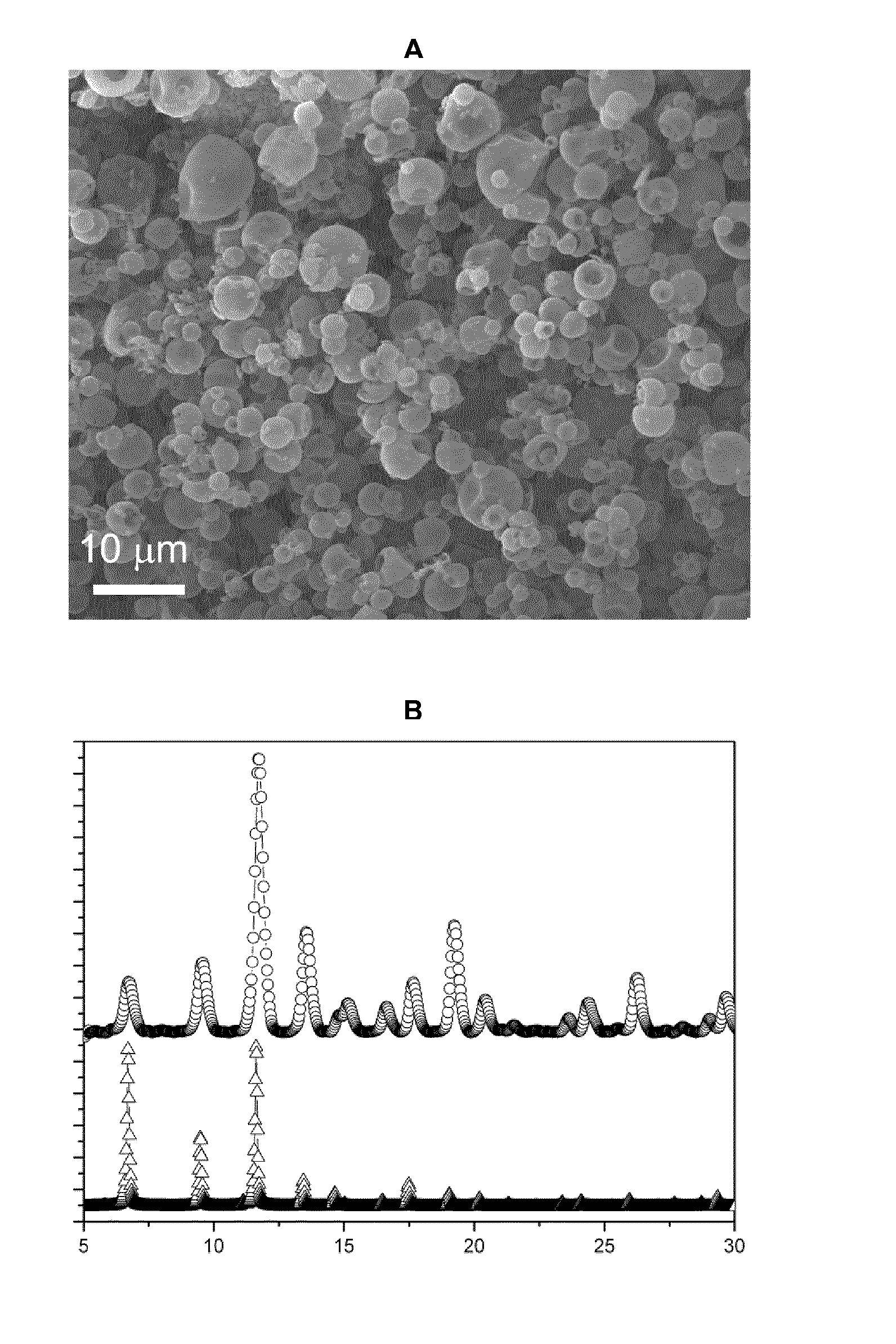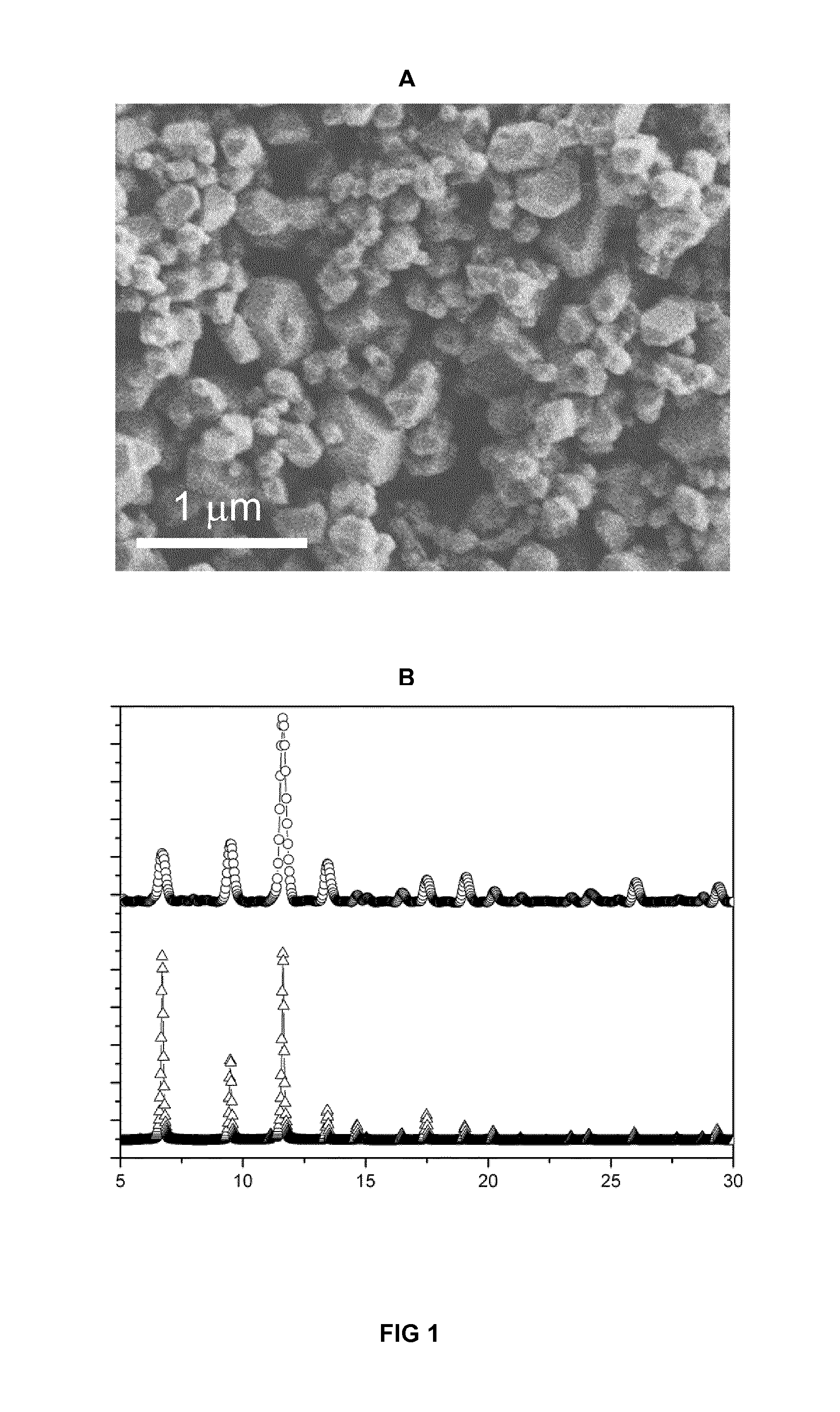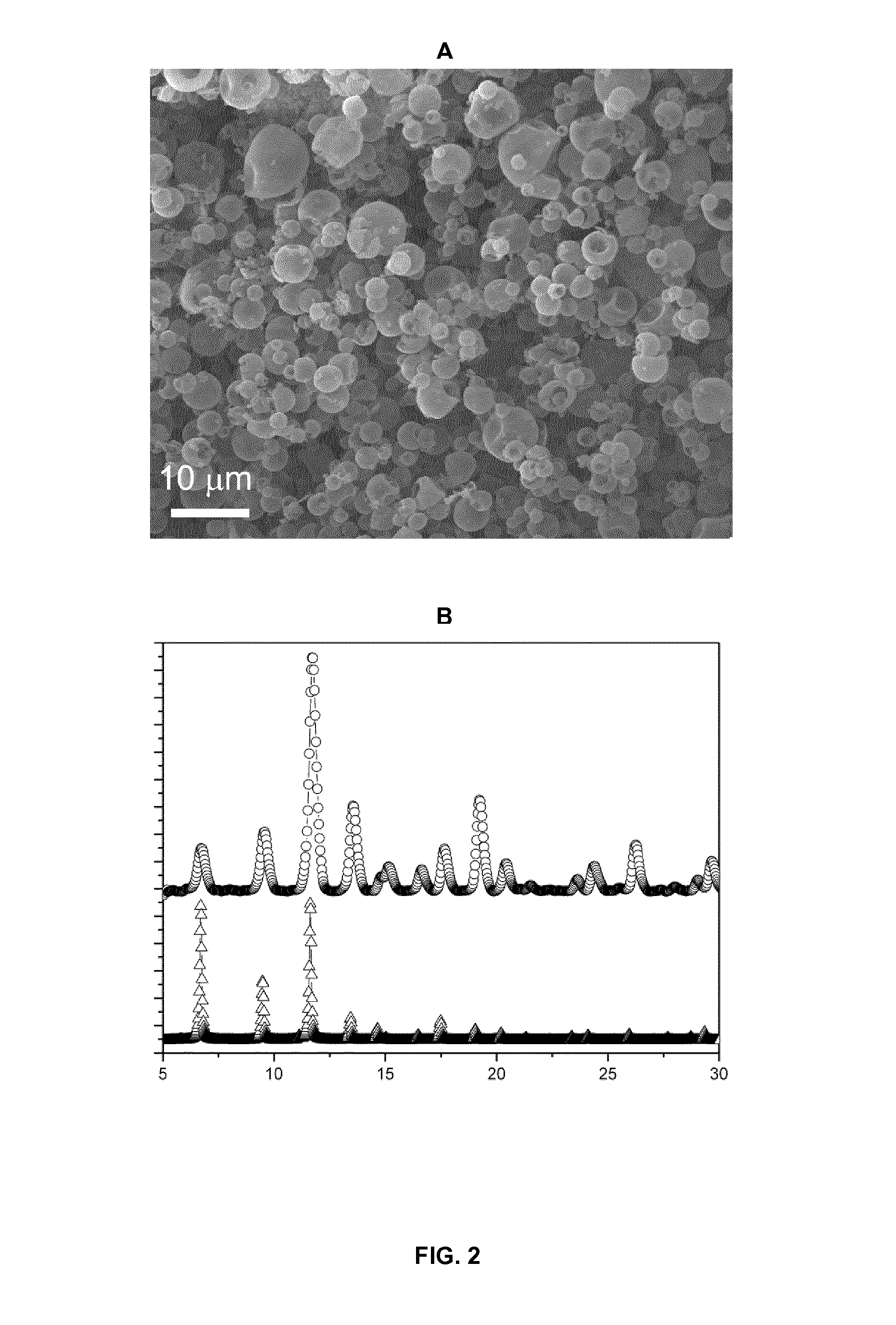Method for the preparation of metal organic frameworks
a metal organic framework and metal technology, applied in the field of metal organic framework preparation, can solve the problems of obstructing the scale-up of mof preparation, reducing time, and requiring an immense scale-up of synthesis, so as to reduce reaction time and reduce time. the effect of time and avoiding a filtering step
- Summary
- Abstract
- Description
- Claims
- Application Information
AI Technical Summary
Benefits of technology
Problems solved by technology
Method used
Image
Examples
example 1
Production of a Cu-benzene-1,3,5-tricarboxylic acid (Cu-1,3,5-BTC) MOF
[0058]2.05 g of Cu(NO3)2.2.5H2O (Sigma-Aldrich) in 25 ml of a mixture of dimethylformamide (DMF, Romil), ethanol (Romil) and water (VDMF:Vethanol:Vwater—1:1:1) was added to a solution of 1.17 g of benzene-1,3,5-tricarboxylic acid (1,3,5-BTC, Sigma-Aldrich) in 25 ml of a mixture of DMF, ethanol and water (VDMF:Vethanol:Vwater—1:1:1). The resulting mixture was spray-dried on the Mini Spray Dryer B-290 (BÜCHI labortechnik AG, Flawil, Switzerland) using a two-fluid nozzle at a feed flow of 4.5 ml / min, gas spray flow of 26.25 m3 / h, inlet air temperature of 180° C., outlet air temperature of 120° C., and with a spray cap with 0.5 mm-hole-size. After 11 minutes a dry blue powder was obtained.
[0059]The dry product (submicron crystals with sizes 150±50 nm) was subsequently washed with 3×60 ml of methanol and dried in vacuum for 12 h at 120° C.
[0060]The yield was 1.45 g (75% w / w). The specific surface area of the MOF (BET ...
example 2
Production of a Cu-1,3,5-BTC MOF
[0062]2.05 g of Cu(NO3)2.2.5H2O (Sigma-Aldrich) in 25 ml of a mixture of DMF (Romil), ethanol (Romil) and water (VDMF:Vethanol:Vwater—1:1:1) were added to a solution of 1.17 g of 1,3,5-BTC (Sigma-Aldrich) in 25 ml of a mixture of DMF, ethanol and water (VDMF:Vethanol:Vwater—1:1:1). The resulting mixture was spray-dried on the Nano Spray Dryer B-90 (BÜCHI labortechnik AG, Flawil, Switzerland) at a feed flow of 2 ml / min, gas spray flow of 26.25 m3 / h, inlet air temperature of 120° C., outlet air temperature of 100° C., and with a spray cap with 7 μm-hole-size. After 12 minutes a dry blue powder was collected.
[0063]The powder (submicron crystals with sizes 150±20 nm) was then washed with 3×60 ml of methanol and dried in vacuum for 12 h at 120° C.
[0064]The yield was 1.56 g (85% w / w). The specific surface area (BET method) was 1266 m2 / g.
example 3
Production of Cu-1,3,5-BTC MOF Capsules
[0065]A solution of 0.317 g of Cu(NO3)2.2.5H2O (Sigma-Aldrich) in 400 ml of a mixture of DMF (Romil), ethanol (Romil) and water (VDMF:Vethanol:Vwater—1:1:1) were added to a solution of 0.185 g of 1,3,5-BTC (Sigma-Aldrich) in 400 ml of a mixture of DMF, ethanol and water (VDMF:Vethanol:Vwater—1:1:1). The resulting mixture was spray-dried on the Mini Spray Dryer B-290 (BÜCHI labortechnik AG, Flawil, Switzerland) using a two-fluid nozzle at a feed flow of 4.5 ml / min, gas spray flow of 26.25 m3 / h, inlet air temperature of 180° C., outlet air temperature of 120° C., and with a spray cap with 0.5 mm-hole-size. After 3 hours a blue powder comprised of microcapsules was obtained. The microcapsules were washed with 2×10 ml of methanol and 10 ml of CH2Cl2. The final product (capsules with sizes 2.5 μm±0.4 μm) was dried in vacuum for 12 h at 120° C.
[0066]The yield was 0.20 g (70% w / w). The specific surface area (BET method) was 1209 m2 / g.
[0067]FIG. 2 show...
PUM
| Property | Measurement | Unit |
|---|---|---|
| Reaction temperature | aaaaa | aaaaa |
| Reaction temperature | aaaaa | aaaaa |
Abstract
Description
Claims
Application Information
 Login to View More
Login to View More - R&D
- Intellectual Property
- Life Sciences
- Materials
- Tech Scout
- Unparalleled Data Quality
- Higher Quality Content
- 60% Fewer Hallucinations
Browse by: Latest US Patents, China's latest patents, Technical Efficacy Thesaurus, Application Domain, Technology Topic, Popular Technical Reports.
© 2025 PatSnap. All rights reserved.Legal|Privacy policy|Modern Slavery Act Transparency Statement|Sitemap|About US| Contact US: help@patsnap.com



